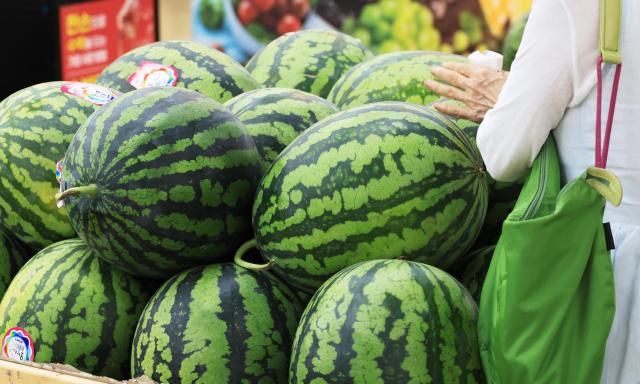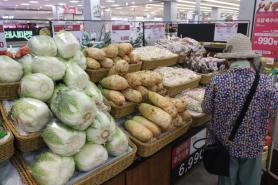
Watermelons and napa cabbage — summertime staples — have seen particularly steep price increases, prompting emergency measures from the government.
As of July 11, the average retail price of a watermelon stood at 29,115 won, or about $21.16, according to data from the Korea Agro-Fisheries and Food Trade Corporation.
The price is up 36.5 percent from a year ago and nearly 39 percent above the average over the past three years.
The spike stems from a confluence of adverse weather conditions. A lack of sunlight in June delayed watermelon crop development, while the onset of intense heat in July accelerated demand.
Producers say the extreme temperatures have reduced sugar content in many watermelons, leading to a supply shortage of high-quality fruit.
Other summer fruits are also feeling the heat. Melons are selling for 10,076 won each, a 21.7 percent increase from a year ago and 16.3 percent higher than the three-year average. Peaches, another seasonal favorite, have climbed about 10 percent in price year over year.
Napa cabbage — a key ingredient in kimchi, Korea’s beloved fermented dish — has shown particularly volatile movements. While current prices are still about 10 percent lower than last year’s levels, they jumped 27.4 percent in just one week to 4,309 won per head, reflecting tightening supply conditions.
Livestock and poultry products have also been affected by the oppressive temperatures. Egg prices have risen nearly 6 percent from last year, reaching 7,162 won for a pack of 30, as consumers turn to protein-rich foods amid the heat.
Chicken prices, currently at 6,070 won per kilogram, remain in line with year-ago levels but are up 11 percent from a month ago — with further increases likely as demand climbs ahead of Chobok, the first of Korea’s traditional “dog days” of summer on July 20.
In response, the government has rolled out emergency supply measures. The Ministry of Agriculture, Food and Rural Affairs said it has secured 35,500 tons of napa cabbage for release during market shortages and prepared 2.5 million backup seedlings to offset crop losses.
For watermelons, officials expect prices to ease later this month as harvests expand to more regions nationwide.
Still, with meteorologists forecasting continued heat into August, officials and consumers alike are bracing for sustained pressure on food prices — and on the resilience of the country’s agricultural system.
Copyright ⓒ Aju Press All rights reserved.




